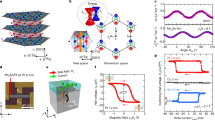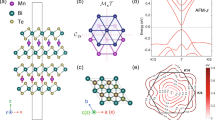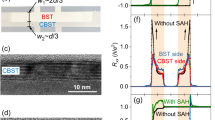Abstract
The quantum metric and Berry curvature are two fundamental and distinct factors that describe the geometry of quantum eigenstates. Although the role of the Berry curvature in governing various condensed-matter states has been investigated extensively, the quantum metric, which has also been predicted to induce topological phenomena, has rarely been studied, particularly at ambient conditions. Here we demonstrate the room-temperature manipulation of the quantum-metric structure of electronic states through its interplay with the interfacial spin texture in a topological chiral antiferromagnet/heavy metal Mn3Sn/Pt heterostructure, which is manifested in a time-reversal-odd second-order Hall effect. We also show the flexibility in controlling the quantum-metric structure with moderate magnetic fields. Our results open the possibility of building applicable nonlinear devices by harnessing the quantum-metric structure.
This is a preview of subscription content, access via your institution
Access options
Access Nature and 54 other Nature Portfolio journals
Get Nature+, our best-value online-access subscription
$29.99 / 30 days
cancel any time
Subscribe to this journal
Receive 12 print issues and online access
$209.00 per year
only $17.42 per issue
Buy this article
- Purchase on Springer Link
- Instant access to full article PDF
Prices may be subject to local taxes which are calculated during checkout




Similar content being viewed by others
Data availability
The data that support the findings of this study are shown in the main text figures and the extended data figures. Source data are provided with this paper.
Code availability
Simulation codes in this paper are available from the corresponding authors upon reasonable request.
References
Provost, J. P. & Vallee, G. Riemannian structure on manifolds of quantum states. Commun. Math. Phys. 76, 289–301 (1980).
Berry, M. V. Quantal phase factors accompanying adiabatic changes. Proc. R. Soc. Lond. A. 392, 45–57 (1984).
Nakatsuji, S., Kiyohara, N. & Higo, T. Large anomalous Hall effect in a non-collinear antiferromagnet at room temperature. Nature 527, 212–215 (2015).
Feng, Z. et al. An anomalous Hall effect in altermagnetic ruthenium dioxide. Nat. Electron. 5, 735–743 (2022).
Ma, Q. et al. Observation of the nonlinear Hall effect under time-reversal-symmetric conditions. Nature 565, 337–342 (2019).
Šmejkal, L., Mokrousov, Y., Yan, B. & MacDonald, A. H. Topological antiferromagnetic spintronics. Nat. Phys. 14, 242–251 (2018).
Gao, Y., Yang, S. A. & Niu, Q. Field induced positional shift of Bloch electrons and its dynamical implications. Phys. Rev. Lett. 112, 166601 (2014).
Neupert, T., Chamon, C. & Mudry, C. Measuring the quantum geometry of Bloch bands with current noise. Phys. Rev. B 87, 245103 (2013).
Piéchon, F., Raoux, A., Fuchs, J.-N. & Montambaux, G. Geometric orbital susceptibility: quantum metric without Berry curvature. Phys. Rev. B 94, 134423 (2016).
Rhim, J. W., Kim, K. & Yang, B. J. Quantum distance and anomalous Landau levels of flat bands. Nature 584, 59–63 (2020).
Peotta, S. & Törmä, P. Superfluidity in topologically nontrivial flat bands. Nat. Commun. 6, 8944 (2015).
Lai, S. et al. Third-order nonlinear Hall effect induced by the Berry-connection polarizability tensor. Nat. Nanotechnol. 16, 869–873 (2021).
Gao, A. et al. Quantum metric nonlinear Hall effect in a topological antiferromagnetic heterostructure. Science 381, 181–186 (2023).
Wang, N. et al. Quantum metric-induced nonlinear transport in a topological antiferromagnet. Nature 621, 487–492 (2023).
Cohen, E. et al. Geometric phase from Aharonov–Bohm to Pancharatnam–Berry and beyond. Nat. Rev. Phys. 1, 437–449 (2019).
Michishita, Y. & Nagaosa, N. Dissipation and geometry in nonlinear quantum transports of multiband electronic systems. Phys. Rev. B 106, 125114 (2022).
Wang, C., Gao, Y. & Xiao, D. Intrinsic nonlinear Hall effect in antiferromagnetic tetragonal CuMnAs. Phys. Rev. Lett. 127, 277201 (2021).
Liu, H. et al. Intrinsic second-order anomalous Hall effect and its application in compensated antiferromagnets. Phys. Rev. Lett. 127, 277202 (2021).
Jeon, K. R. et al. Long-range supercurrents through a chiral non-collinear antiferromagnet in lateral Josephson junctions. Nat. Mater. 20, 1358–1363 (2021).
Qin, P. et al. Room-temperature magnetoresistance in an all-antiferromagnetic tunnel junction. Nature 613, 485–489 (2023).
Chen, X. et al. Octupole-driven magnetoresistance in an antiferromagnetic tunnel junction. Nature 613, 490–495 (2023).
Tsai, H. et al. Electrical manipulation of a topological antiferromagnetic state. Nature 580, 608–613 (2020).
Takeuchi, Y. et al. Chiral-spin rotation of non-collinear antiferromagnet by spin–orbit torque. Nat. Mater. 20, 1364–1370 (2021).
Han, J., Cheng, R., Liu, L., Ohno, H. & Fukami, S. Coherent antiferromagnetic spintronics. Nat. Mater. 22, 684–695 (2023).
Yoon, J. et al. Crystal orientation and anomalous Hall effect of sputter-deposited non-collinear antiferromagnetic Mn3Sn thin films. Appl. Phys. Express 13, 013001 (2020).
Nembach, H. T., Shaw, J. M., Weiler, M., Jué, E. & Silva, T. J. Linear relation between Heisenberg exchange and interfacial Dzyaloshinskii–Moriya interaction in metal films. Nat. Phys. 11, 825–829 (2015).
Cheng, Y., Yu, S., Zhu, M., Hwang, J. & Yang, F. Tunable topological Hall effects in noncollinear antiferromagnet Mn3Sn/Pt bilayers. APL Mater. 9, 051121 (2021).
Liu, J. J. et al. Robust interface-induced unusual anomalous Hall effect in Mn3Sn/Pt bilayers. Rare Met. 41, 3012–3018 (2022).
Wang, X. et al. Topological Hall effect in thin films of an antiferromagnetic Weyl semimetal integrated on Si. ACS Appl. Mater. Interfaces 15, 7572–7577 (2023).
Kang, K., Li, T., Sohn, E., Shan, J. & Mak, K. F. Nonlinear anomalous Hall effect in few-layer WTe2. Nat. Mater. 18, 324–328 (2019).
Kumar, D. et al. Room-temperature nonlinear Hall effect and wireless radiofrequency rectification in Weyl semimetal TaIrTe4. Nat. Nanotechnol. 16, 421–425 (2021).
Avci, C. O. et al. Unidirectional spin Hall magnetoresistance in ferromagnet/normal metal bilayers. Nat. Phys. 11, 570–575 (2015).
Yokouchi, T. et al. Electrical magnetochiral effect induced by chiral spin fluctuations. Nat. Commun. 8, 866 (2017).
Yasuda, K. Current-nonlinear Hall effect and spin-orbit torque magnetization switching in a magnetic topological insulator. Phys. Rev. Lett. 119, 137204 (2017).
He, P. et al. Nonlinear planar Hall effect. Phys. Rev. Lett. 123, 016801 (2019).
Kuroda, K. et al. Evidence for magnetic Weyl fermions in a correlated metal. Nat. Mater. 16, 1090–1095 (2017).
Uchimura, T. et al. Observation of domain structure in non-collinear antiferromagnetic Mn3Sn thin films by magneto-optical Kerr effect. Appl. Phys. Lett. 120, 172405 (2022).
Li, S. et al. Nanoscale magnetic domains in polycrystalline Mn3Sn films imaged by a scanning single-spin magnetometer. Nano Lett. 23, 5326–5333 (2023).
Manchon, A. et al. Current-induced spin-orbit torques in ferromagnetic and antiferromagnetic systems. Rev. Mod. Phys. 91, 035004 (2019).
He, P. et al. Graphene moiré superlattices with giant quantum nonlinearity of chiral Bloch electrons. Nat. Nanotechnol. 17, 378–383 (2022).
Tokura, Y. & Nagaosa, N. Nonreciprocal responses from non-centrosymmetric quantum materials. Nat. Commun. 9, 3740 (2018).
Du, Z. Z., Wang, C. M., Sun, H. P., Lu, H. Z. & Xie, X. C. Quantum theory of the nonlinear Hall effect. Nat. Commun. 12, 5038 (2021).
Isobe, H., Xu, S. Y. & Fu, L. High-frequency rectification via chiral Bloch electrons. Sci. Adv. 6, aay2497 (2020).
Lebrun, R. et al. Tunable long-distance spin transport in a crystalline antiferromagnetic iron oxide. Nature 561, 222–225 (2018).
Yoon, J.-Y. et al. Handedness anomaly in a non-collinear antiferromagnet under spin–orbit torque. Nat. Mater. 22, 1106–1113 (2023).
Schlotter, S., Agrawal, P. & Beach, G. S. D. Temperature dependence of the Dzyaloshinskii–Moriya interaction in Pt/Co/Cu thin film heterostructures. Appl. Phys. Lett. 113, 092412 (2018).
Ito, N. & Nomura, K. Anomalous Hall effect and spontaneous orbital magnetization in antiferromagnetic Weyl metal. J. Phys. Soc. Jpn 86, 063703 (2017).
Watanabe, J., Araki, Y., Kobayashi, K., Ozawa, A. & Nomura, K. Magnetic orderings from spin–orbit coupled electrons on kagome lattice. J. Phys. Soc. Jpn 91, 083702 (2022).
Hu, J., Xu, S., Ni, N. & Mao, Z. Transport of topological semimetals. Annu. Rev. Mater. Res. 49, 207–252 (2019).
Bai, H. et al. Size-dependent anomalous Hall effect in noncollinear antiferromagnetic Mn3Sn films. Appl. Phys. Lett. 117, 052404 (2020).
Min, L. et al. Strong room-temperature bulk nonlinear Hall effect in a spin-valley locked Dirac material. Nat. Commun. 14, 364 (2023).
Ikhlas, M. et al. Piezomagnetic switching of the anomalous Hall effect in an antiferromagnet at room temperature. Nat. Phys. 18, 1086–1093 (2022).
Han, J. H. et al. Antiferromagnet-controlled spin current transport in SrMnO3/Pt hybrids. Phys. Rev. B 90, 144431 (2014).
Ji, Y. et al. Spin Hall magnetoresistance in an antiferromagnetic magnetoelectric Cr2O3/heavy-metal W heterostructure. Appl. Phys. Lett. 110, 262401 (2017).
Althammer, M. et al. Quantitative study of the spin Hall magnetoresistance in ferromagnetic insulator/normal metal hybrids. Phys. Rev. B 87, 224401 (2013).
Olejník, K., Novák, V., Wunderlich, J. & Jungwirth, T. Electrical detection of magnetization reversal without auxiliary magnets. Phys. Rev. B 91, 180402(R) (2015).
Yasuda, K. et al. Large unidirectional magnetoresistance in a magnetic topological insulator. Phys. Rev. Lett. 117, 127202 (2016).
Liu, Y. T. et al. Determination of spin–orbit-torque efficiencies in heterostructures with in-plane magnetic anisotropy. Phys. Rev. Appl. 13, 044032 (2020).
Fan, Y., Saha, R., Yang, Y. & Wang, J. P. Origins of observational errors in field sweep DC measurements for unidirectional magnetoresistance. J. Appl. Phys. 132, 213907 (2022).
Liu, J. & Balents, L. Anomalous Hall effect and topological defects in antiferromagnetic Weyl semimetals: Mn3Sn/Ge. Phys. Rev. Lett. 119, 087202 (2017).
Acknowledgements
We thank T. Dietl for valuable discussions. A portion of this work was supported by the Japan Society for the Promotion of Science (JSPS; KAKENHI Grant Nos. 19H05622 to S.F., 22K03538 to Y.A. and 22KF0035 to J.H.), the Initiative to Establish Next-Generation Novel Integrated Circuits Centers (X-NICS) funded by the Ministry of Education, Culture, Sports, Science and Technology (Grant No. JPJ011438 to S.F.) and the Casio Science and Technology Foundation (Grant No. 40-4 to Y.T.). J.H. acknowledges support from the JSPS Postdoctoral Fellowship for Research in Japan. T.U. and J.-Y.Y. acknowledge support from GP-Spin at Tohoku University.
Author information
Authors and Affiliations
Contributions
S.F. and J.H. planned the study. T.U. prepared and characterized the stacks and fabricated the devices with input from J.H., J.-Y.Y. and Y.T. J.H. and T.U. performed the transport measurements and analysed the data with input from Y.Y., S.K. and S.F. Y.A. performed the theoretical modelling with input from J.I. All authors discussed the results. J.H., Y.A. and S.F. wrote the paper with input from T.U., J.I. and H.O.
Corresponding authors
Ethics declarations
Competing interests
The authors declare no competing interests.
Peer review
Peer review information
Nature Physics thanks Haizhou Lu, Su-Yang Xu and the other, anonymous, reviewer(s) for their contribution to the peer review of this work.
Additional information
Publisher’s note Springer Nature remains neutral with regard to jurisdictional claims in published maps and institutional affiliations.
Extended data
Extended Data Fig. 1 Six degenerate configurations of the chiral-spin structure of Mn3Sn and corresponding directions of the applied magnetic field.
The Mn atoms in red and yellow locate in two neighboring kagome planes, respectively.
Extended Data Fig. 2 ScHE measured at different frequencies of the applied current I = 4 mA.
The applied magnetic field of 0.4T is along the +x axis of Fig. 2a. The solid line indicates that we do not observe a frequency dependence of \({V}_{{\rm{H}}}^{\;2{\rm{\omega }}}\).
Extended Data Fig. 3 Longitudinal angle-dependent magnetoresistance of the (0001)-oriented Mn3Sn/Pt measured by a d.c. of 4 mA and magnetic fields of 0.4 and 4 T.
The solid lines are fits to 180°-periodic sinusoidal functions.
Extended Data Fig. 4 ScHE and AHE of the (0001)-oriented Mn3Sn/MgO or Ta.
a, ScHE measured by applying an a.c. of 4 mA and rotating an in-plane magnetic field of 0.4 T. No field angle dependence is observed at even higher fields. b, Hall resistance measured by applying a d.c. of 0.5 mA and sweeping a magnetic field along the film normal. The linear background is kept here.
Extended Data Fig. 5 AHE and ScHE of the \(({\mathbf{1}}{\mathbf{\bar{1}}}{\mathbf{00}})\) -oriented Mn3Sn/Pt.
a, Measurement configuration. The current is applied along the \([11\bar{2}0]\) direction. β and γ scans correspond to the field rotation in zx and yz planes, respectively. b, Hall resistance measured by applying a d.c. of 0.5 mA as well as sweeping a magnetic field perpendicular to the film plane or rotating a magnetic field of 4 T for β scan. A large field of 4 T overcomes the perpendicular magnetic anisotropy and ensures a coherent rotation of the chiral-spin structure with the field. c, ScHE measured by applying an ac current of 4 mA and rotating a magnetic field of 4 T for β and γ scans. The β scan of 0.4 T has the same trend as that of 4 T but even smaller bumps. The result of the (0001)-oriented Mn3Sn/Pt at 4 mA and 0.4 T (α scan) is accompanied for comparison.
Extended Data Fig. 6 Structure of the effective model used in the theoretical calculations.
a, Kagome bilayer lattice. A unit cell contains six sites, (Ab, Bb, Cb) on the bottom layer and (At, Bt, Ct) on the top layer. The black dot represents the inversion center of the unit cell. b, c, Directions of the DMI vectors Dij (red arrows) for the nearest neighboring sites. If one takes i and j as the starting and end points of each link, Dij points to the direction shown as the small red arrow. Panels b and c denote \({{\bf{D}}}_{{ij}}^{{\rm{loc}}}\) and \({{\bf{D}}}_{{ij}}^{\mathrm{int}}\), respectively. The directions of the spin-orbit field vectors νij for the nearest neighboring sites follow the red arrows in panel b. The brown and grey arrows denote the displacement from one atom site to another.
Extended Data Fig. 7 Momentum-space distributions of the built-in Berry curvature \({[{{\boldsymbol{\Omega }}}_{\boldsymbol{n}}({\bf{k}})]}^{\boldsymbol{z}}\), the electrically induced Berry curvature \({[{{\boldsymbol{\Omega }}}_{\boldsymbol{n}}^{{\boldsymbol{(E\;)}}}({\bf{k}})]}^{\boldsymbol{z}}\), and its symmetric part \({[{{\boldsymbol{\Omega }}}_{\boldsymbol{n}}^{{\boldsymbol{(E\;)}}}({\bf{k}})]}_{{\mathbf{symm}}}^{\boldsymbol{z}}\) (unit: \({\boldsymbol{a}}_{\mathbf{0}}^{\mathbf{2}}\)) under the inverse triangular chiral-spin structure, calculated from the kagome bilayer model (\({\bf{E}}{\boldsymbol{\parallel}} +{\boldsymbol{x}}\) and \({\boldsymbol{\alpha}} ={\mathbf{0}}^{\boldsymbol{\circ}}\)).
a–c, Results without out-of-plane spin canting. d, e, f, Results with out-of-plane spin canting of the top layer due to the i-DMI. The solid-line hexagons correspond to the first Brillouin zone of the kagome lattice. Panels c and f have been shown in Fig. 3c. These results are calculated from the third lowest band in Fig. 3b.
Extended Data Fig. 8 ScHE in the (0001)-oriented Mn3Sn/Pt device with the applied current along \({\boldsymbol{y}}{\boldsymbol{\parallel}} {\boldsymbol{[}}{\mathbf{1}}{\mathbf{\bar{1}}}{\mathbf{00}}{\boldsymbol{]}}\).
a, Theoretical modeling. b, Experiment.
Extended Data Fig. 9 Theoretically calculated second-order longitudinal and transverse conductivity \({\boldsymbol{\sigma }}_{{\mathbf{s}}}^{\;\boldsymbol{xxx}}\) and \({\boldsymbol{\sigma }}_{{\bf{s}}}^{\;\boldsymbol{yxx}}\) under two mechanisms.
a, Scattering on the asymmetric Fermi surface. b, Intrinsic quantum-metric structure.
Source data
Source Data for Fig. 1
Source data for Fig. 1d–f.
Source Data for Fig. 2
Source data for Fig. 2b–d.
Source Data for Fig. 3
Source data for Fig. 3a,b,d,e.
Source Data for Fig. 4
Source data for Fig. 4a–d.
Source Data for Extended Data Fig. 2
Source data for Extended Data Fig. 2.
Source Data for Extended Data Fig. 3
Source data for Extended Data Fig. 3.
Source Data for Extended Data Fig. 4
Source data for Extended Data Fig. 4.
Source Data for Extended Data Fig. 5
Source data for Extended Data Fig. 5.
Source Data for Extended Data Fig. 8
Source data for Extended Data Fig. 8.
Source Data for Extended Data Fig. 9
Source data for Extended Data Fig. 9.
Rights and permissions
Springer Nature or its licensor (e.g. a society or other partner) holds exclusive rights to this article under a publishing agreement with the author(s) or other rightsholder(s); author self-archiving of the accepted manuscript version of this article is solely governed by the terms of such publishing agreement and applicable law.
About this article
Cite this article
Han, J., Uchimura, T., Araki, Y. et al. Room-temperature flexible manipulation of the quantum-metric structure in a topological chiral antiferromagnet. Nat. Phys. (2024). https://doi.org/10.1038/s41567-024-02476-2
Received:
Accepted:
Published:
DOI: https://doi.org/10.1038/s41567-024-02476-2



